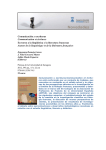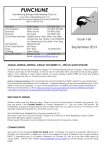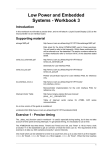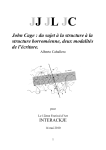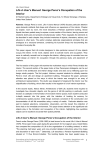Download newslitter 7
Transcript
Metalepsis Seminar • Virtual Session 7 metalepsis seminar / WAAC•PSU / 12 February 2014 EXTERNAL BRAINS: "THE TRUTH IS OUT THERE—LITERALLY!" METALEPSIS SEMINARIANS, 9-ERS, AND AUXILIARY MEMBERS thanks again, David Levine did we forget to mention lipograms? The art of melancholy doesn't arrive on its own; it has to be invited, it has to be constructed. And, we have to be aware of the relation of the gap, the omission, the sudden ending to melancholy's need for nothing, "and a lot of it." Georges Perec's amazing project of lipogrammatology, La Disparition (Paris: Denoël, 1969), translated by Gilbert Adair as A Void, shows how effective melancholy can be without our awareness that we are all the time making, in this novel without the letter 'e', circumlocutions. The question is — and Perec surely endorses this in his other book, Life, a User's Manual — isn't circumlocution a way of spatializing the unconscious? This is a tantalizing clue, for it endorses the Lucretian "even flow of atoms along a void" as ordinary experience's "grammatical mode." Turbulence (clinamen) happens when there is an OBSTACLE that can't be symbolized. This is, if we dare call it by name, is the "part" or "partial object" of Lacanian fame, and we know through our calculus of metalepsis that it is the ø/-ø of demonic invasion, Eros (cf. Venustas). Just as La Disparition is able to "map the negative," the missing 'e', our avoidances — hollows, swerves, detours, short-cuts, etc. — all talk about the objects we can't talk about. Reverse-engineer this. The hollow, swerve, detour, etc. amounts to "body loading" in Apollo Robbins' sense. The object that didn't/couldn't exist now negatively exists thanks to the space that now conceals it. Manage this space and you will begin to think like an architect! evidence Chirality opens up a world. A very small world. It is the world of those who have discovered it, and decided that the best way to keep it secret is put it out in the open: the "purloined letter" technique. This is appearing more and more to be the case with the DianaActæon myth, told so many times by so many authors you would think that the public would get tired of hearing it, but despite the mutliple re-tellings the "secret" is still intact. Like the lipogram, the secret creates a site of exception around Actæon's transition from inventory cathexis to sinthome cathexis. The roundabout movements of the narrative combine, Vico tells us, to constitute a means of human consciousness based on the idea of a sacred site. NOTE: this is not the "sacred" of retail-level phenomenology but a connection of distance with preparation and readiness. Travel along one, constitute the other. This is the crane shot of Notorious. Cathexis is not only an investment made in an object or objects in a field, it is a "packing" that takes place along the sagittal dimension orthogonal to the field — hence Hitchcock's discovery of the technique of building up anxiety as one travels along this dimension to create a scale crisis where, at some extreme point, cathexis will be forced to shift gear. This kind of talk may seem strange at first, but consider the prestigious list of those who have been "signalizing" to us using the purloined letter PR scheme: (1) the story of Simonides, and the birth of artificial memory — really the birth of "IT"; (2) Camillo's memory theater, with its one position out of place; (3) Dante's use of the number 9; (4) Vico's whistle-blower leak of the whole secret in paragraph 528; (5) Vanvitelli's portrayal of the Diana/Actæon myth at Caserta; (6) E. A. Poe's dramatic demonstration in 1845; (7) Joyce's cosmic deployment in Finnegans Wake; (8) re-discoveries and employments all along that we may have missed (Cervantes, Shakespeare, Rabelais), plus the modern ones we have ignored: Hitchcock, Lynch, John Ford, Apollo Robbins. In some of these, examples Diana and Actæon are mentioned by name, in some they are de-personified (a reversal of the personification process of myth), and in some they are simply the space of the field and the path. But, when Wallace Stevens describes a "Jar in Tennessee," we know in advance where the jar is, and what it holds: "It made the slovenly wilderness / Surround that hill." Freed of "interpretation," we can go directly to enactment, in the good company of those who know just what this letter is and where to put it. Don't forget that it is only through the language invented by Freud and Lacan that we can begin to call the shots on how chirality works to establish subjectivity. And, when Agent Mulder of The X-Files used to say (and was quoted by Žižek frequently), "The truth is out there," we are able, thanks to Lacan, to remember the POSITION OF TRUTH, i.e. that it's a place in the spatial field designated for the four discourses. As Paul Verhaeghe points out, TRUTH is in both the fourth position and the first position. It is the thing that has been "dropped out" at the initial moment of enunciation, the énoncé that, like the "Bomb!" shout that clears the room, does not have to be present, in fact its absence is the very thing that gets results. Meaning that "resonates from a distance" uses the logic of metonymy. From a distance???? This is architecture stuff. Distance must be constructed — by the Imaginary — and the distance "from which Truth resonates from a point of origin," to appear at an end that will have apocalyptic results, is an interesting concept! It may be that 4/1 is "for one." tricks of the trade Our business is, unfortunately, not in the corporate headquarters of Great Ideas but down in the retail outlets where everyday sales figures are tallied and compared. We have papers to write, exams to give and/or pass, colleagues to collaborate with, or not. We are, as the poet Vladimir Mayakovsky said to comfort a lone woman fellow-passenger on a dark street car when he walked on board, "Don't worry, madame, I am just a cloud in pants." We don't want to scare the hell out of anyone with crazy talk, but neither do we wish to given into the happy talk of ideology. Marjorie Perloff has unearthed some lost lines from the deeply sad (melancholic?) Mayakovsky that we might regard as advice: "I want to be understood by my country, and if I am not — never mind, I will pass over my native land sideways, as a slanted rain passes." There is a story in Swedish folklore about fairies who live in our four dimensions (three plus time) the same way two-dimensional silhouettes live in a 3-D space. To disappear, they "just turn sideways." This is not impossible. A reality check reveals that "body loading" creates just the right extra dimension to allow a four dimensional being to create an extra dimension into which it may turn sideways. In other words, if you believe in what you are talking about, it should be real enough to use in life. Turning sideways in a thesis or research paper amounts to taking a fake step backwards. For work that is too bold for prime time, an essay that wishes to support it can frame it in the negative, and this critical-skeptical askesis allows for a bit of rotation of the objectat-hand. Here, I've re-formatted an old essay, a disguised book review of a non-existent book, worked up for publication in New Observations. Below is a diagram of that happens in the academy. You sign up for courses, the courses are taught, usually responsibly. The instructor has a reputation to defend so to some extent discourse must be controlled by regulating lines we could describe as an inventory field. The whole field is not explored, but some lines form the limit beyond which it is senseless to travel. In almost all fields, in the US and Canada at least, Lacan and Vico are outside these lines. Deleuze and sometimes Rancière are in, but usually in their own well defended sub-zone. If you find yourself as a student in a class, you cannot be impolite or disruptive, so you must respect the cathected field. But, there are two ways of "going outside." You cannot bring the monsters in from the terra incognita, that is unfair. You can however dig some holes. If you are really a special kind of dreamer, you can float above the whole field as one does in dreams of flying. Up or down, you have extimacy at your service, and the physics of extimacy has been laid out for some centuries by the traditions of melancholy. This is a special form of theatrics, so it is also good to go to acting class to learn stagecraft. You MUST work under the radar. And, when you are teaching a class yourself, you have to create both the cathected field (everyone expects it – it's the course outline basically), and then offer the caves and mountain tops as places for some to discover the ironic limitations of the field. This is where the savages at the marginal jungles turn out to be the guides in the hotel lobby and musicians and waiters in the bar, insiders and outsiders at the same time. It's up to you to be a good director, so it helps to study films to find out what directors do. Here's one trick: A fake step backwards can be anything from pretending to not know something, revealing a weakness, or simply opening up a blank spot in a field of knowledge or a thinker's position. This is enough to pull the field cathexis of the class or topic past the scale-limited breaking point, and from that point on it's a new ball game. Remember that the two moves are related. You must create a void to allow cathexis to be pulled past the point where the scale of the inventory dominates. Is this too technical? Think of the structure of anomaly. It's the same thing. It not only "disproves" prevailing theory in an area of study, it restructures the frame and the dimensions with when a new view will be structured. That keeps a Ph.D., for example, from being simply an extension of an old framework of knowledge. It MUST BE new, it MUST challenge the old frame. It should not (as most art history dissertations are) the extension of an old catalog. A new inventory is acceptable but (1) hard work, (2) hard to establish, and (3) probably unacceptable by those using the old inventory. Since you have to do the trick part before you do the new inventory, you can do just the trick part and leave the inventory to others with more time on their hands. In effect, you create a "zairja" condition when you shift from inventory to sinthome, because at this point the reader, the writer, and everyone else become indistinguishable. They are all players in a single consciousness that Maurice Halbwachs recognized was a single collective memory. This is also what Giulio Camillo realized but no one has yet acknowledged. Do not be afraid you will be giving away any secrets. These kinds of truths are secrets that "keep themselves." The creation of a void into which cathexis can rush in and be structured by the sinthome is precisely what Perec (and before him Vico) realized would happen. when nothing else comes to mind: laughter Occasionally you meet people from outside the reservation who don't know what reversed predication is. Hard to imagine, yes, but what do you say? There are some examples that can be used as a test. If the outsider gets the point then they can be trusted; if not, then the rule applies: "The half-life of missing the point is forever." Here is one possible test. In the case of laughter (crying works just as well) it is almost always the case that the object that provokes the laughter is insignificant in comparison to the laughter itself, which compels everyone to laugh. Even those who don't know or understand what they are laughing at are laughing, and they "really mean it." When you hear a joke in a language you don't understand, you can sometimes be provoked into laughing by a number of factors outside the strict meaning of words. In such cases, the best explanation of events is that "laughter is laughing the laughers." The laughers are automatons who a material causes of the laughter but the laughter itself has the "message." In the case of professional mourners, which Žižek often cites, the mourners "automate" the process of mourning but, like Tibetan prayer wheels, they perform the essential service of allowing the mourner to have private rather than public reactions. An extension of this automation argument requiring reversed predication is another Žižek example, of a collection of videos or music CDs that are able to "do the watching/listening for you," that is you are relieved of responsibility to have to do it all yourself. The collection has the authority to reversely predicate the situation. This is clear in many collections of art, esp. by museums, where the function of spectatorship has been automated. That no one actually looks at the art is the intended main function of the museum — and perhaps this is good because if people actually looked at art they would be compelled to go insane! That is, the true radical content of most works of art has to be "domesticated" by art historians to see art as "examples of …" rather than as sites of exception, places of radical transformed meaning. Occasionally there are times when this protective cover is blown off and the artwork gets to you anyway. In this case the artwork "laughs" or "cries" through whoever is standing nearby. workshop ideas The opportunity to do workshops, one in Cincinnati and one in Los Angeles, has provoked the thought … what the hell should we do? Can't just show more film clips. They should be performances that engage and provoke, with an idea that can be expanded by each individual participant in a unique way. Props and the use of "stage space" is essential … any theatrical idea you have will be appreciated. With only 30 minutes or so to convert the skeptics, the presentation has to be tight and witty. The background essay first draft is finished and available. NEWSLITTER ARCHIVE 1—january 1 2—january 8 3—january 15 4—january 22 5—january 29 6—february 5 remember our motto: "unlimited semiosis!"




